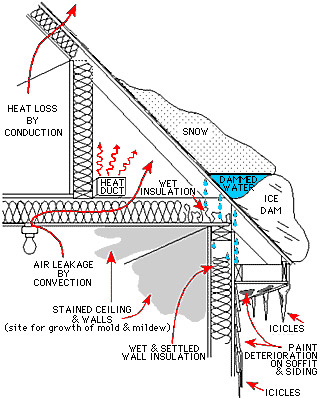- Roofing
- Siding
- Gutters
- General Services
- Insurance Claims
- Color Viewer
- Testimonials
- Photos
- Credentials
- Contact Us
Ice Dams
Removing snow and ice from your roof should only be done by a professional. Anyone on your roof is risking personal injury and damages to your home.
If the person is injured and is not properly insured, you are responsible for their injuries. If the person damages your roof, your warranty is void and you are responsible for the repairs.
What is an ice dam?
An ice dam is a ridge of ice that forms at the edge of a roof and prevents melting snow (water) from draining off the roof. The water that backs up behind the dam can leak into a home and cause damage to walls, ceilings, insulation, and other areas. Figure 1 shows a cross section of a home with an ice dam.
What causes ice dams?
 There is a complex interaction among the amount of heat loss from a house, snow cover, and outside temperatures that leads to ice dam formation. For ice dams to form there must be snow on the roof, and, at the same time, higher portions of the roof's outside surface must be above 32°F while lower surfaces are below 32°F. For a portion of the roof to be below 32°F, outside temperatures must also be below 32°F. When we say temperatures above or below 32°F, we are talking about average temperature over sustained periods of time.
There is a complex interaction among the amount of heat loss from a house, snow cover, and outside temperatures that leads to ice dam formation. For ice dams to form there must be snow on the roof, and, at the same time, higher portions of the roof's outside surface must be above 32°F while lower surfaces are below 32°F. For a portion of the roof to be below 32°F, outside temperatures must also be below 32°F. When we say temperatures above or below 32°F, we are talking about average temperature over sustained periods of time.
The snow on a roof surface that is above 32°F will melt. As water flows down the roof it reaches the portion of the roof that is below 32°F and freezes. Voila!—an ice dam.
The dam grows as it is fed by the melting snow above it, but it will limit itself to the portions of the roof that are on the average below 32°F. So the water above backs up behind the ice dam and remains a liquid. This water finds cracks and openings in the exterior roof covering and flows into the attic space. From the attic it could flow into exterior walls or through the ceiling insulation and stain the ceiling finish.
Nonuniform roof surface temperatures lead to ice dams.
Under extreme conditions, with heavy snow and severe cold, almost any house can have an ice dam, whereas a house that is poorly insulated with attic bypasses will have ice dams during a normal winter weather. Giant icicles hanging from the eave are one indication of a poorly insulated attic with many attic bypasses.
Preventing and dealing with ice dams
In all MA communities it is possible to find homes that do not have ice dams. Ice dams can be prevented by controlling the heat loss from the home.
Immediate action:
- Remove snow from the roof. This eliminates the main ingredient necessary for the formation of an ice dam. A "roof rake" and push broom can be used to remove snow, but may damage the roofing materials. It is best to contact a trained and fully insured roofer to do this work.
Long-term action:
- First, make the ceiling air tight so no warm, moist air can flow from the house into the attic space.
- After sealing air leakage paths between the house and attic space, consider increasing the ceiling/roof insulation to cut down on heat loss by conduction.
WARNING!
- Any person on the roof during the winter or performing work on the roof from below is risking injury and risking damage to the roof and house. It is important to contact professionals to carry out this job.
- Whenever a house is tightened up, ventilation systems, exhausting devices, and combustion devices must have enough air to operate safely and effectively!
Interior damage should not be repaired until ceilings and walls are dry. In addition, interior repair should be done together with correcting the heat loss problem that created the ice dam(s) or the damage will occur again.


